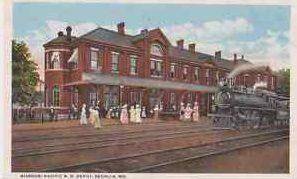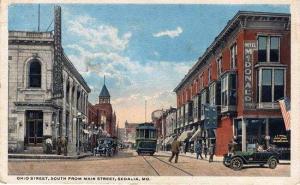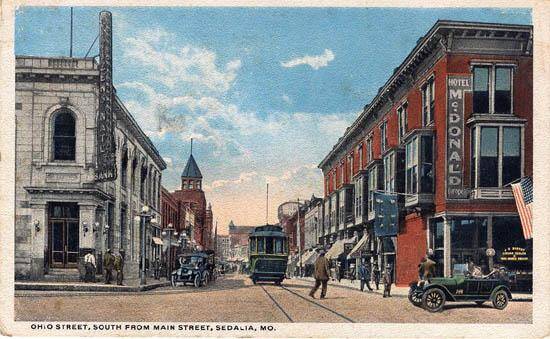Haze of Memory
 Not very much happened of ragtime interest in Sedalia in the years after World War I. The bustling town moseyed along, growing a bit, but generally it settled into a social and commercial routine centered on the railroads.
Not very much happened of ragtime interest in Sedalia in the years after World War I. The bustling town moseyed along, growing a bit, but generally it settled into a social and commercial routine centered on the railroads.
However, by the 1940’s an awareness of the town’s ragtime heritage began to awaken and I’m blowing off the dust this month to tell the story of the town’s reacquaintance with Scott Joplin.
In his book Brunson Campbell: The Original Ragtime Kid (McFarland and Company: 2016) Larry Karp details the life of one of Scott Joplin’s first white students. Specifically, I have been intrigued by Campbell’s effort to convince the Sedalia community in the 1940’s of the significance of their musical heritage.
Brun Campell’s Campaign
After years of silence, Brun Campbell began a campaign to promote the legacy of Scott Joplin across the country. He had the support of Joplin’s alleged spouse Lottie and he even attracted the support of W.C. Handy. His promotions, letter writing efforts and his articles in The Record Changer with Roy Carew had attracted the attention of the columnist, E.V. Durling, and things began to happen.
 A Summer 1947 newspaper headline in the Sedalia Democrat “Did You Know Ragtime Music Was Born in Sedalia?” began to stir interest in the city’s ragtime past. George Scruton, the paper’s editor apparently received a letter about a Chicago Herald column “On the Side” by Durling declaring Sedalia’s role in the beginnings of the country’s formerly popular ragtime music.
A Summer 1947 newspaper headline in the Sedalia Democrat “Did You Know Ragtime Music Was Born in Sedalia?” began to stir interest in the city’s ragtime past. George Scruton, the paper’s editor apparently received a letter about a Chicago Herald column “On the Side” by Durling declaring Sedalia’s role in the beginnings of the country’s formerly popular ragtime music.
From Scruton’s reaction, apparently few in the community including the editor did know about their ragtime connection. He wrote a letter to Durling who referred him to Brun Campbell and that led to Scruton’s article and the declaration of ragtime fame. It also was the beginning of the modern interest in Sedalia’s ragtime heritage, culminating in 37 Joplin Festivals.
Early Acknowledgements
 It is easy to conjecture that Durling knew about Sedalia from R.J. Carew and Brun Campbell’s two-part article in a 1945 The Record Changer titled “Sedalia, Missouri, the Cradle of Ragtime” or one in 1947, titled “A Pioneer Rag Man” by Campbell and Carew. Carew was a frequent jazz commentator and Brun Campbell, “The Ragtime Kid,” had come to Sedalia in the late 1890’s to study Ragtime under Joplin’s tutelage. Then after a short career as an itinerant ragtime performer he settled down in Venice, California to be a barber.
It is easy to conjecture that Durling knew about Sedalia from R.J. Carew and Brun Campbell’s two-part article in a 1945 The Record Changer titled “Sedalia, Missouri, the Cradle of Ragtime” or one in 1947, titled “A Pioneer Rag Man” by Campbell and Carew. Carew was a frequent jazz commentator and Brun Campbell, “The Ragtime Kid,” had come to Sedalia in the late 1890’s to study Ragtime under Joplin’s tutelage. Then after a short career as an itinerant ragtime performer he settled down in Venice, California to be a barber.
Other articles began appearing in Sedalia papers as Tom Ireland, an original ragtime instrumentalist and perennial newspaper employee, was consulted about the Ragtime Era in Sedalia. A Sedalia Democrat article in November 1947, featured the Queen City Negro Band and was reprinted from DownBeat magazine. The caption over Ireland’s photo of the band read “This Was Taken When Ragtime Was New.”
Additionally, a radio program in 1948 and the persistent promotion of the California barber brought the music back to Sedalia’s attention.
The radio program was distributed by the Union Electric Co. as “Mr. Ragtime” on their Land We Live In (series seven) and was broadcast over station KDRO, Sedalia. It was promoted as “a recorded program of Scott Joplin Music” on Wednesday evening July 14th. The public was invited to listen and learn how to win a Scott Joplin Record Album. It is the closing lines of a newspaper ad touting the program that indicates interest in Sedalia ragtime had not declined altogether, “Scott Joplin Proves the Sedalia Claim that the First Jazz Music Was Written and Published in Sedalia.”
Sedalians were informed in a 1949 article that Brun Campbell’s Scott Joplin Papers had been donated to the Fish (Fisk) Library in Nashville very possibly due to encouragement from Tom Ireland who had been corresponding with Campbell. Ireland had graduated college in Nashville and probably knew of Anna Bontemps work in the library there. Still another article about the role of bands in Sedalia’s cultural life began with a description of the Queen City Concert Band’s role.
The Fifties
 Then in 1950, Brun Campbell who had been trying to promote his idea for a massive Joplin monument on the composer’s grave, next began sending a deluge of letters to the Sedalia Democrat and they began to be referenced in a column titled “Music Modes.” The Democrat’s music editor, Charles Hanna, Jr., began with a February 1950 article about the limited exposure Sedalians have to jazz and critiqued the few radio programs that reached the prairie airways.
Then in 1950, Brun Campbell who had been trying to promote his idea for a massive Joplin monument on the composer’s grave, next began sending a deluge of letters to the Sedalia Democrat and they began to be referenced in a column titled “Music Modes.” The Democrat’s music editor, Charles Hanna, Jr., began with a February 1950 article about the limited exposure Sedalians have to jazz and critiqued the few radio programs that reached the prairie airways.
In April, a “Music Modes” column bemoans the fact that there didn’t seem to be any organization willing to take up the ragtime banner and promote the city’s musical heritage. By then Campbell had W.C. Handy, the DownBeat editor, and the Fisk people writing to the Democrat-Capital encouraging the city to recognize Joplin in some significant way.
Continuing the barrage, the music editor next refers to a Harper’s Magazine article describing the roots of Jazz in ragtime and ragtime’s roots in Sedalia.
In May 1950 the promotion for Sedalia to do something substantial to honor Joplin’s ragtime contributions began to reap results when the Chamber of Commerce organized a committee for the purpose of deciding on a permanent memorial. When the group failed to act immediately, the music editor came back with a vengeance admonishing the Chamber for not acting. A week later the editor refers to “Sedalia’s immortal Joplin” and “American music’s benefactor” and a re-run of the old “Did You Know…” article was promised to keep the Chamber on task. As threatened (promised) it appeared in October.
Mention of They All Played Ragtime by Harriet Janis and Rudi Blesh published in 1950 was emphasized in the October article and the book’s reference to Sedalia as “The Cradle of Ragtime” resonated through the city. Blesh and Janis had visited Sedalia in 1949 to gather background for the book and stirred some interest in what they were doing.
 Memorial Concert
Memorial Concert
It took the better part of a year to plan and produce the Memorial Concert and the plaque that was to be presented at the same time. Finally, on April 17, 1951, the commemoration was held. Everything came together and Sedalia fulfilled its obligation to its ragtime heritage. For Sedalia, this wasn’t just any concert event. The program honored a man of color and it was held in the all-black Hubbard High School. The mixed-race audience in this otherwise segregated town enjoyed the evening by all accounts.
Mayor Herb Struder traced the history of Joplin’s compositions and Sedalia’s role in enabling his creativity. Edythe Rose played the “Maple Leaf Rag” followed by selections from the Sedalia Men’s Choral Club directed by Abe Rosenthal. Then the special plaque was presented by Z. Lyle Brown, Choral Club President, to J.B. Hylick, Hubbard principal. The plaque was displayed in the high school until the school was closed in 1973 but remains in the building today reconfigured as a residence center.
To the surprise of most Sedalians, the story hit the wire services and it appeared across the country. It was soon followed by a newswire out of New York in August calling for a Ragtime Revival and citing the Sedalia concert and plaque as the incentive for this resurgent interest. What took so long to promote, was finally successful, probably well beyond Brun Campbell’s expectations.
———–
I want to extend my sincere appreciation to all who have sent condolence messages on Karen’s death. She was a co-founder of the 1974-75 Sedalia ragtime festivals, a 45-year practicing registered nurse and my wife of 52 years. We are all given many talents that raise us up in life, but when it came to care for others, at five foot two inches, she was the tallest person I have ever known.
Larry Melton was a founder of the Scott Joplin Ragtime Festival in 1974 and the Sedalia Ragtime Archive in 1976. He was a Sedalia Chamber of Commerce manager before moving on to Union, Missouri where he is currently helping to conserve the Ragtime collection of the Sedalia Heritage Foundation. Write him at lcmelton67@gmail.com.






















